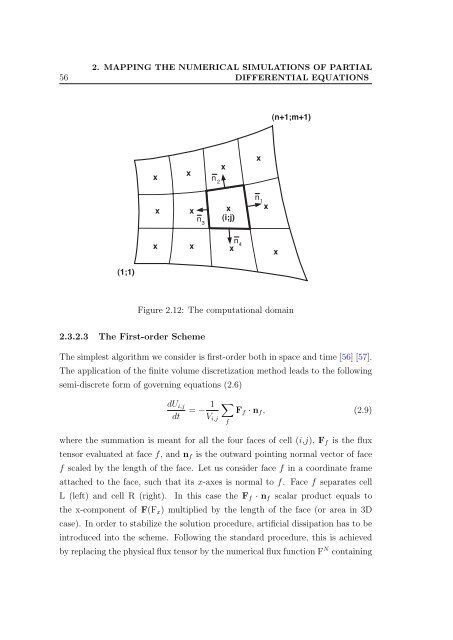PPKE ITK PhD and MPhil Thesis Classes
PPKE ITK PhD and MPhil Thesis Classes
PPKE ITK PhD and MPhil Thesis Classes
Create successful ePaper yourself
Turn your PDF publications into a flip-book with our unique Google optimized e-Paper software.
56<br />
2. MAPPING THE NUMERICAL SIMULATIONS OF PARTIAL<br />
DIFFERENTIAL EQUATIONS<br />
(n+1;m+1)<br />
x<br />
x<br />
n 2<br />
x<br />
x<br />
x x x<br />
(i;j)<br />
n 1<br />
x<br />
x<br />
x<br />
n 3<br />
n 4<br />
x<br />
x<br />
(1;1)<br />
Figure 2.12: The computational domain<br />
2.3.2.3 The First-order Scheme<br />
The simplest algorithm we consider is first-order both in space <strong>and</strong> time [56] [57].<br />
The application of the finite volume discretization method leads to the following<br />
semi-discrete form of governing equations (2.6)<br />
dU i,j<br />
dt<br />
= − 1 ∑<br />
F f · n f , (2.9)<br />
V i,j<br />
where the summation is meant for all the four faces of cell (i,j), F f is the flux<br />
tensor evaluated at face f, <strong>and</strong> n f is the outward pointing normal vector of face<br />
f scaled by the length of the face. Let us consider face f in a coordinate frame<br />
attached to the face, such that its x-axes is normal to f. Face f separates cell<br />
L (left) <strong>and</strong> cell R (right). In this case the F f · n f scalar product equals to<br />
the x-component of F(F x ) multiplied by the length of the face (or area in 3D<br />
case). In order to stabilize the solution procedure, artificial dissipation has to be<br />
introduced into the scheme. Following the st<strong>and</strong>ard procedure, this is achieved<br />
by replacing the physical flux tensor by the numerical flux function F N containing<br />
f






![optika tervezés [Kompatibilitási mód] - Ez itt...](https://img.yumpu.com/45881475/1/190x146/optika-tervezacs-kompatibilitasi-mad-ez-itt.jpg?quality=85)









